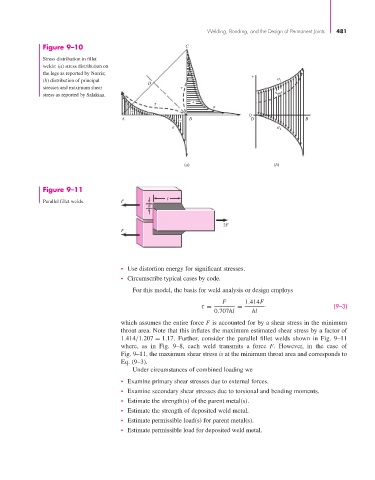Page 506 - Shigley's Mechanical Engineering Design
P. 506
bud29281_ch09_475-516.qxd 12/16/2009 7:12 pm Page 481 pinnacle 203:MHDQ196:bud29281:0073529281:bud29281_pagefiles:
Welding, Bonding, and the Design of Permanent Joints 481
Figure 9–10 C
Stress distribution in fillet
welds: (a) stress distribution on
the legs as reported by Norris; +
(b) distribution of principal D 1
stresses and maximum shear
stress as reported by Salakian. max
+
+
0
A − B D B
2
(a) (b)
Figure 9–11
Parallel fillet welds. F l
h
2F
F
• Use distortion energy for significant stresses.
• Circumscribe typical cases by code.
For this model, the basis for weld analysis or design employs
F 1.414F
τ = = (9–3)
0.707hl hl
which assumes the entire force F is accounted for by a shear stress in the minimum
throat area. Note that this inflates the maximum estimated shear stress by a factor of
1.414/1.207 = 1.17. Further, consider the parallel fillet welds shown in Fig. 9–11
where, as in Fig. 9–8, each weld transmits a force F. However, in the case of
Fig. 9–11, the maximum shear stress is at the minimum throat area and corresponds to
Eq. (9–3).
Under circumstances of combined loading we
• Examine primary shear stresses due to external forces.
• Examine secondary shear stresses due to torsional and bending moments.
• Estimate the strength(s) of the parent metal(s).
• Estimate the strength of deposited weld metal.
• Estimate permissible load(s) for parent metal(s).
• Estimate permissible load for deposited weld metal.

